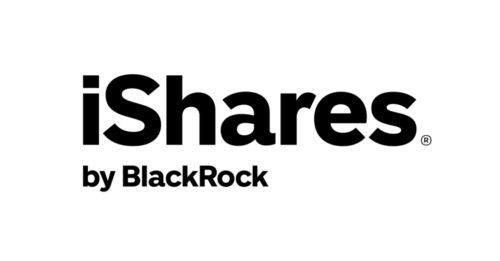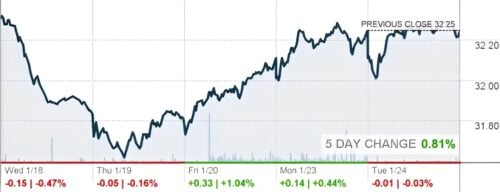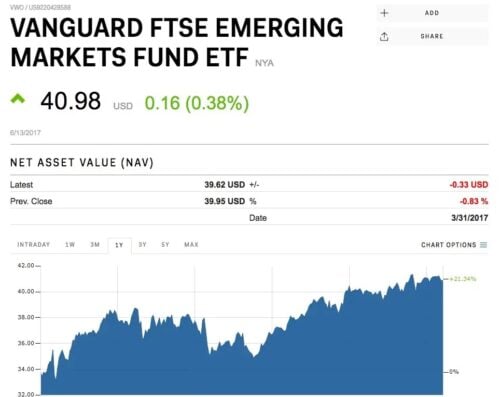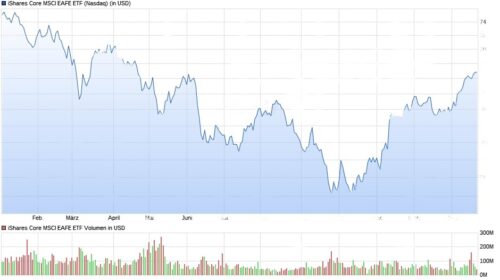World exchange-traded funds (ETFs) offer the best of our global economy and can be a boon to your investment portfolio.
Not sure which ones to pick up? Read on to learn about our favorite world ETFs to buy for 2023.
Best World ETFs To Add
Although its ticker name sounds like an odd grunt, the iShares MSCI World ETF is one of our favorite world ETFs.
It has exposure to a broad range of developed markets worldwide, all rolled into one fund.
The majority of companies still hail from the United States, but URTH includes several other key geographic locations.
Among those are Japan, the United Kingdom, Australia, Canada, France, and many other European nations.
Stocks come from various sectors, with information technology leading the way. Other heavily weighted industries include financials, health care, and industrials.
There are 1,511 holdings in all. These stocks have a combined $2.65 billion in net assets under management.

At the top of the holdings ladder are three well-established American companies.
Apple Inc (NASDAQ: AAPL) carries 4.09% of the total weight, followed by Microsoft Corp (NASDAQ: MSFT) at 3.16% and Amazon.com Inc (NASDAQ: AMZN) at 1.60%.
URTH seeks to mirror the MSCI World Index. It has historically slightly outperformed its counterpart since its inception in 2012.
Few world ETFs had a good 2022, and iShares MSCI World ETF is no exception.
Despite a bad year, the fund has increased 125% on the share price charts over the last ten years.
With expected long-term, slow growth, it makes sense that URTH will change directions and continue its gradual climb as the market turns back around.
The expense ratio to buy-in is 0.24%, but the ETF pays back around 1.75% in dividends.
Vanguard Total World Stock ETF (NYSEARCA: VT)
Vanguard’s Total World Stock ETF invests in both domestic and foreign stocks for a diverse piece of the global economy.
It tracks the FTSE Global All Cap Index, which covers developed and emerging markets.
The fund has a high potential for growth and a healthy dose of risk. Share values tend to be more volatile than funds focusing solely on US or international stocks.
North America still represents the lion’s share of companies but has a good dose of European and Pacific markets mixed in.
The ETF also captures several organizations representing emerging markets around the world.
Like its benchmark, VT contains over 9,500 stocks from nearly every market type.

Total net asset value totals $34.6 billion and includes a blend of value and growth large-cap stocks.
Although many company stocks call VT home, its highest-weighted holdings are well-established American enterprises.
Apple Inc (NASDAQ: AAPL) represents 3.35% of the fund, with Microsoft Corp (NASDAQ: MSFT) at 2.82% and Amazon.com Inc (NASDAQ: AMZN) at 1.27%.
Even with occasional ups and downs, the Vanguard Total World Stock ETF is up 81%.
VT’s expense ratio is surprisingly low at just 0.07%. One could expect a dividend yield of just over 2% when investing.
Thanks to short-term volatility, VT is only a good portfolio choice for someone investing in the long game.
Be prepared for declines along the way as the fund strives for potentially high returns that come with the risk.
The iShares Core MSCI Total International Stock ETF kicks American companies to the curb, focusing entirely on the rest of the world.
It includes a wide range of internationally developed and emerging markets at a relatively low cost.
IXUS opens the door to 4,300 international stocks, offering the chance to diversify your portfolio. These companies account for over $30 billion in total net asset value.
Geographically, the fund invests most heavily in Japanese organizations but has a robust mix of markets worldwide. All six continents with an active economy have a presence here.
Sector breakdowns place financials at the top, followed by industrial and consumer discretionary.

Moving down the list, information technology and health care round out the top five.
Although weights are fairly evenly split among securities, Taiwan Semiconductor Manufacturing (TPE: 2330) reigns king with 1.44% of the total. Nestle SA (SWX: NESN) has 1.21%, and Tencent Holdings Ltd (HKG: 700) owns 1.07%.
The fund tracks with the MSCI ACWI ex-USA IMI Index and has done an excellent job following its total return since its inception in 2012.
A few dips in the road have IXUS at an overall share value gain of 26%.
IXUS is already having a good year, and investors consider it a low-risk moving forward. It has underperformed compared to its US counterparts, but this trend could end anytime.
A 0.07% expense ratio shouldn’t significantly impact your bottom line if you choose to invest. In December, IXUS paid its shareholder base $0.49 per share.
SPDR Portfolio Developed World ex-US ETF (NYSEARCA: SPDW)
SPDR Portfolio Developed World ex-US ETF is one of the lower-cost world ETFs available. This makes it more accessible to investors at all levels.
The fund provides diverse exposure to core asset classes from international equities. It tracks the S&P® Developed Ex-U.S. BMI Index, but interestingly has less than half the number of holdings.
SPDW contains 2,529 securities, covering a range of countries with developed markets. Assets within represent nearly $14 billion.
Its geographical breakdown heavily favors Japan, with the United Kingdom and Canada also having a significant presence.
Other markets include the majority of Europe, Australia, and East Asia.
The ETF features several sectors, allocated primarily to financials and industrials. Investors will also see a spread of consumer discretionary, health care, and consumer staple stocks.

None of SPDW’s biggest holdings represent more than a 1.5% total weight. Nestle SA (SWX: NESN) sits on top, with ASML Holding NV (NASDAQ: ASML) and Samsung Electronics Co Ltd (KRX: 005930) rounding out the top three.
A gross expense ratio of 0.04% is among the lowest we’ve seen for any ETF, let alone on the world front. The fund has a current 3.0% dividend yield.
SPDW is down slightly from its entry point into the market back in 2007. Fortunately, the ETF’s current trends look to change all that.
Despite its shortcomings, SPDW has all the makings of a suitable long-term ETF for any investment portfolio.
Its global approach could mitigate country-specific risk, leading to nice gains over time.
Vanguard FTSE Emerging Markets ETF (NYSEARCA: VWO)
The Vanguard FTSE Emerging Markets ETF unsurprisingly invests in stocks of companies located in the world’s emerging markets.
It strives to meet the returns of the FTSE Emerging Markets All Cap China A Inclusion Index.
ETF and index are quite similar, but VWO carries over 1,000 more stocks among its ranks. These 5,575 securities total more than $95.5 billion in net asset value.
Over 99% of VWO’s stocks come from emerging economies on the global stage. China has the most significant presence, with India, Taiwan, and Brazil not far behind.
In all, these countries offer stocks spanning a vast number of sectors. The mix of both countries and markets bring a good amount of diversity.

Its anchor company is Taiwan Semiconductor Manufacturing (TPE: 2330), with 4.56% of the total fund.
Tencent Holdings Ltd (HKG: 700) maintains 3.22%, and Alibaba Group Holding Ltd (HKG: 9988) has the third spot at 2.32%.
Due to several risk factors, VWO is prone to extremely wide fluctuations in its share price. The fund’s performance since its inception in 2005 is rocky but still up 66% overall.
Because of these swings, VWO may be too unpredictable for short-term strategies.
Investors willing to bunker down through the ETF’s ups and downs are likelier to come out ahead.
If Vanguard’s FTSE Emerging Markets ETF speaks to you, expense ratio fees are just 0.08%. The current dividend yield, also known to fluctuate some, currently sits at 3.8%.
iShares’ Core MSCI EAFE ETF pulls from a broad spectrum of companies in strategic parts of the world. The fund aims to capture the total return of the MSCI EAFE IMI Index.
Net assets of the Core MSCI EAFE ETF are the highest of any on our list at just over $93 billion. A total of 3,015 securities account for such a high asset value.
IEFA draws solely from developed countries. It fits well at the core of a portfolio to diversify internationally and grow long-term.
The ETF does not feature countries from South America or Africa, investing solely in Europe, Australia, and the Far East.
Japan is its highest contributor, followed closely by the United Kingdom and France.
Sector demographics offer a fairly even split between financials, industrials, and healthcare.

Several more markets have been added to this list, providing a diverse economic breakdown.
No one stock carries a significant amount of weight, thanks to such an array of companies. Nestle SA (SWX: NESN), ASML Holding NV (NASDAQ: ASML), and LVMH Moet Hennessy Louis Vuitton (EPA: MC) hold the top spots.
IEFA’s performance has seen some movement over time, creating its highest share value at the end of 2021.
After 2022’s dip, the ETF remains up 35% over time and appears to be heading back in a positive direction.
Grabbing this comprehensive access to developed international stocks will only cost you 0.07% of your gains as the cost of doing business.
Investors can look forward to 2.5% dividends while expecting long-term growth.
Are World ETFs a Good Investment?
A well-balanced portfolio has exposure to a range of industries. Buying many stocks on your own can get pricey and become difficult to juggle.
ETFs, in general, tend to contain a bountiful mix of hundreds to thousands of stocks from a particular niche.
With a single investment, you gain access to all these securities without the management woes.
By nature, a single exchange-traded fund can create diversity that is needed at the core of any investment portfolio. This diversity often quells some of the volatility found with individual stocks.
As a result, ETFs usually experience slow growth over several years. They may not be a good choice for the short term, but they rarely lose out in the long run.
World ETFs add even more diversity to the pot, incorporating investments on a global scale. This extra exposure can smooth out bumps when one country’s economy flounders.
When picking out some world ETFs to add to your portfolio, consider whether you want to choose developed markets or emerging economies. Each comes with varying risk factors and rewards.
Developed nations have stability, but companies within often grow slower. Emerging markets are more volatile but may lead to higher returns.
No matter which way you go, we’ve got you covered with our picks in this article. We feel anyone can help you score a win, but do your research before diving in.
Frequently Asked Questions (FAQs)
What Is The Best Vanguard International ETF?
We believe the two Vanguard international ETFs listed above are excellent choices for this year. While not an exhaustive list, either one has the potential to reach new heights during 2023.
What Are The Riskiest ETFs?
ETFs dealing with microcap stocks tend to be the riskiest. While they can undoubtedly lead to high returns, these funds can be unreliable.
Is There a World Index?
The MSCI World Index represents large and mid-cap stocks across 23 developed countries. Similarly, the FTSE Global All Cap Index contains securities in both developed and emerging markets.
Are ETFs Riskier Than Mutual Funds?
ETFs and mutual funds each carry about the same level of risk. Each has pros and cons, and you should always research before modifying your trading strategy.
How Much Should I Invest in International ETFs?
Everyone invests differently, but around 20% of your portfolio in international stocks and bonds can offer great diversification.


 Tags:
Tags:










